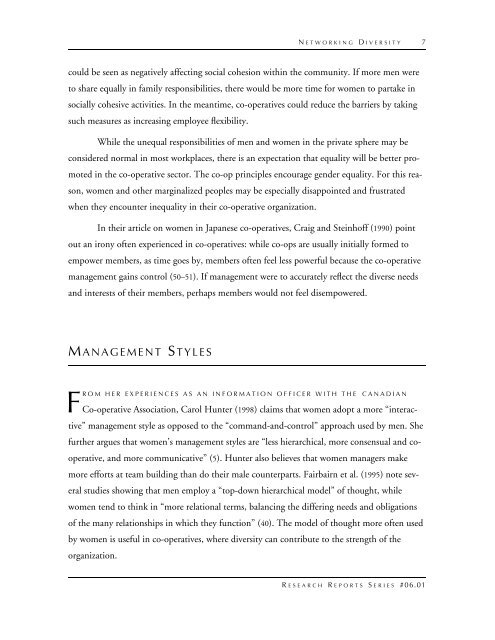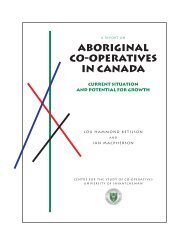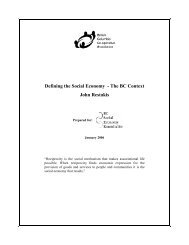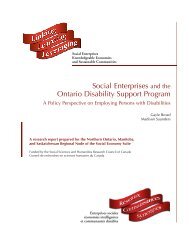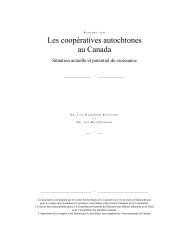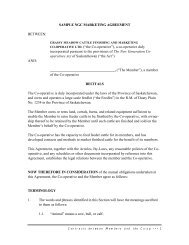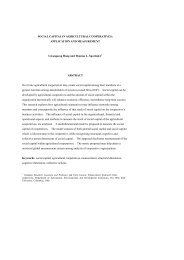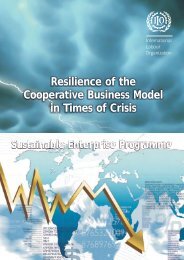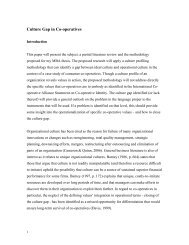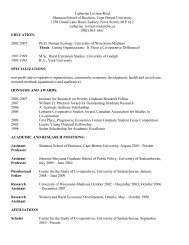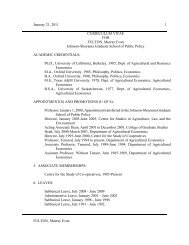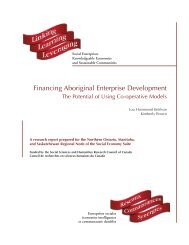Network Diversity - Centre for the Study of Co-operatives
Network Diversity - Centre for the Study of Co-operatives
Network Diversity - Centre for the Study of Co-operatives
Create successful ePaper yourself
Turn your PDF publications into a flip-book with our unique Google optimized e-Paper software.
N E T W O R K I N G D I V E R S I T Y 7<br />
could be seen as negatively affecting social cohesion within <strong>the</strong> community. If more men were<br />
to share equally in family responsibilities, <strong>the</strong>re would be more time <strong>for</strong> women to partake in<br />
socially cohesive activities. In <strong>the</strong> meantime, co-<strong>operatives</strong> could reduce <strong>the</strong> barriers by taking<br />
such measures as increasing employee flexibility.<br />
While <strong>the</strong> unequal responsibilities <strong>of</strong> men and women in <strong>the</strong> private sphere may be<br />
considered normal in most workplaces, <strong>the</strong>re is an expectation that equality will be better promoted<br />
in <strong>the</strong> co-operative sector. The co-op principles encourage gender equality. For this reason,<br />
women and o<strong>the</strong>r marginalized peoples may be especially disappointed and frustrated<br />
when <strong>the</strong>y encounter inequality in <strong>the</strong>ir co-operative organization.<br />
In <strong>the</strong>ir article on women in Japanese co-<strong>operatives</strong>, Craig and Steinh<strong>of</strong>f (1990) point<br />
out an irony <strong>of</strong>ten experienced in co-<strong>operatives</strong>: while co-ops are usually initially <strong>for</strong>med to<br />
empower members, as time goes by, members <strong>of</strong>ten feel less powerful because <strong>the</strong> co-operative<br />
management gains control (50–51). If management were to accurately reflect <strong>the</strong> diverse needs<br />
and interests <strong>of</strong> <strong>the</strong>ir members, perhaps members would not feel disempowered.<br />
M A N A G E M E N T S T Y L E S<br />
FR O M H E R E X P E R I E N C E S A S A N I N F O R M A T I O N O F F I C E R W I T H T H E<br />
C A N A D I A N<br />
<strong>Co</strong>-operative Association, Carol Hunter (1998) claims that women adopt a more “interactive”<br />
management style as opposed to <strong>the</strong> “command-and-control” approach used by men. She<br />
fur<strong>the</strong>r argues that women’s management styles are “less hierarchical, more consensual and cooperative,<br />
and more communicative” (5). Hunter also believes that women managers make<br />
more ef<strong>for</strong>ts at team building than do <strong>the</strong>ir male counterparts. Fairbairn et al. (1995) note several<br />
studies showing that men employ a “top-down hierarchical model” <strong>of</strong> thought, while<br />
women tend to think in “more relational terms, balancing <strong>the</strong> differing needs and obligations<br />
<strong>of</strong> <strong>the</strong> many relationships in which <strong>the</strong>y function” (40). The model <strong>of</strong> thought more <strong>of</strong>ten used<br />
by women is useful in co-<strong>operatives</strong>, where diversity can contribute to <strong>the</strong> strength <strong>of</strong> <strong>the</strong><br />
organization.<br />
R E S E A R C H R E P O R T S S E R I E S # 0 6 . 0 1


